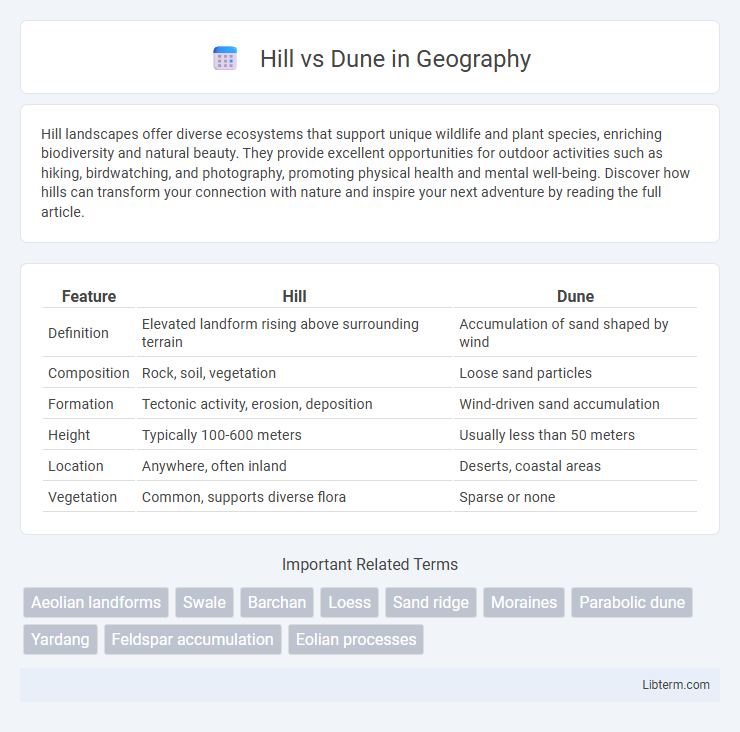Hill landscapes offer diverse ecosystems that support unique wildlife and plant species, enriching biodiversity and natural beauty. They provide excellent opportunities for outdoor activities such as hiking, birdwatching, and photography, promoting physical health and mental well-being. Discover how hills can transform your connection with nature and inspire your next adventure by reading the full article.
Table of Comparison
| Feature | Hill | Dune |
|---|---|---|
| Definition | Elevated landform rising above surrounding terrain | Accumulation of sand shaped by wind |
| Composition | Rock, soil, vegetation | Loose sand particles |
| Formation | Tectonic activity, erosion, deposition | Wind-driven sand accumulation |
| Height | Typically 100-600 meters | Usually less than 50 meters |
| Location | Anywhere, often inland | Deserts, coastal areas |
| Vegetation | Common, supports diverse flora | Sparse or none |
Introduction to Hills and Dunes
Hills and dunes are natural landforms shaped by geological and environmental processes. Hills are elevated areas of land with a distinct summit, formed through tectonic activity, erosion, or volcanic eruptions. Dunes consist of wind-blown sand accumulations typically found in deserts or coastal regions, constantly reshaped by wind patterns.
Defining Hills: Characteristics and Formation
Hills are elevated landforms characterized by gentle slopes and lower elevations compared to mountains, typically ranging between 100 to 600 meters in height. They form through geological processes such as erosion, tectonic activity, or volcanic eruptions, shaping landscapes over millions of years. Hilltops often provide distinct ecological niches and influence local climate patterns, contributing to biodiversity and human settlement.
What is a Dune? Key Features Explained
A dune is a natural landform composed of wind-deposited sand grains, typically found in deserts and coastal regions. Key features include its crescent or linear shape, composed of well-sorted sand particles, and its dynamic nature influenced by wind direction and velocity. Unlike a hill, which is primarily formed by geological uplift or erosion, a dune is a constantly shifting mound shaped by aeolian processes.
Geological Processes Behind Hills
Hills are primarily formed through geological processes such as tectonic activity, erosion, and sediment deposition, which shape their structure and elevation over time. Uplift from plate movements and folding of rock layers contribute to the rise of hills, while weathering and erosion gradually contour their slopes. Sediment accumulation in certain environments can also build hills through sedimentary layering and compaction.
How Dunes Are Formed: Wind and Sediment
Dunes are formed through the interaction of wind and sediment, where wind transports loose particles such as sand across arid or coastal landscapes. As the wind velocity decreases, sand grains accumulate and create mounds or ridges known as dunes, which vary in shape depending on wind direction and sediment supply. Unlike hills, which are primarily shaped by tectonic activity and erosion, dunes are dynamic landforms continually reshaped by wind processes.
Differences in Composition: Rock vs Sand
Hill consists primarily of compacted rock formations such as limestone, granite, or basalt, providing a solid and stable structure. Dunes are composed mainly of loose, granular sand particles shaped by wind, resulting in a constantly shifting and less stable terrain. The mineral content and cohesiveness between hill rock and dune sand create distinct geological and ecological environments.
Ecological Impact: Hills vs Dunes
Hills maintain stable ecosystems with diverse plant roots that prevent soil erosion and support wildlife habitats, promoting long-term ecological balance. Dunes, shaped by wind, feature specialized flora and fauna adapted to shifting sands, playing a crucial role in coastal protection and nutrient cycling. Both formations contribute uniquely to biodiversity and environmental stability, with hills offering structural soil integrity and dunes providing dynamic buffer zones against natural forces.
Human Interaction with Hills and Dunes
Hills and dunes both shape human interaction with landscapes by influencing settlement patterns, agriculture, and recreational activities. Hills, often composed of bedrock or compacted soil, provide stable foundations for housing and infrastructure, while dunes, formed by wind-driven sand, present dynamic environments prone to shifting and require adaptive land management. Human engagement with dunes emphasizes conservation and controlled access to prevent erosion, whereas hills support diverse uses from hiking trails to terraced farming.
Famous Hills and Dunes Around the World
Famous hills like Arthur's Seat in Scotland and Capitol Hill in Washington D.C. are iconic landmarks known for their historical and cultural significance. Renowned dunes such as the Sahara Desert's Erg Chebbi in Morocco and the Great Sand Dunes in Colorado showcase the vast beauty of shifting sands and unique ecosystems. Both hills and dunes attract millions of visitors annually, offering diverse landscapes and outdoor activities around the world.
Conclusion: Hill vs Dune – Key Takeaways
Hill offers a luxurious and modern design with an emphasis on high-end finishes and spacious layouts, appealing to buyers seeking elegance and comfort. Dune prioritizes functionality and affordability, providing practical living spaces with efficient use of square footage, ideal for budget-conscious families. Evaluating Hill vs Dune depends on preferences for upscale aesthetics versus cost-effective, practical housing solutions, reflecting divergent priorities in real estate choices.
Hill Infographic

 libterm.com
libterm.com